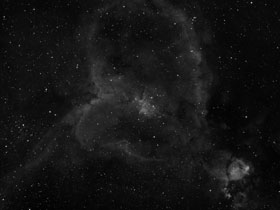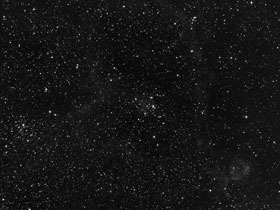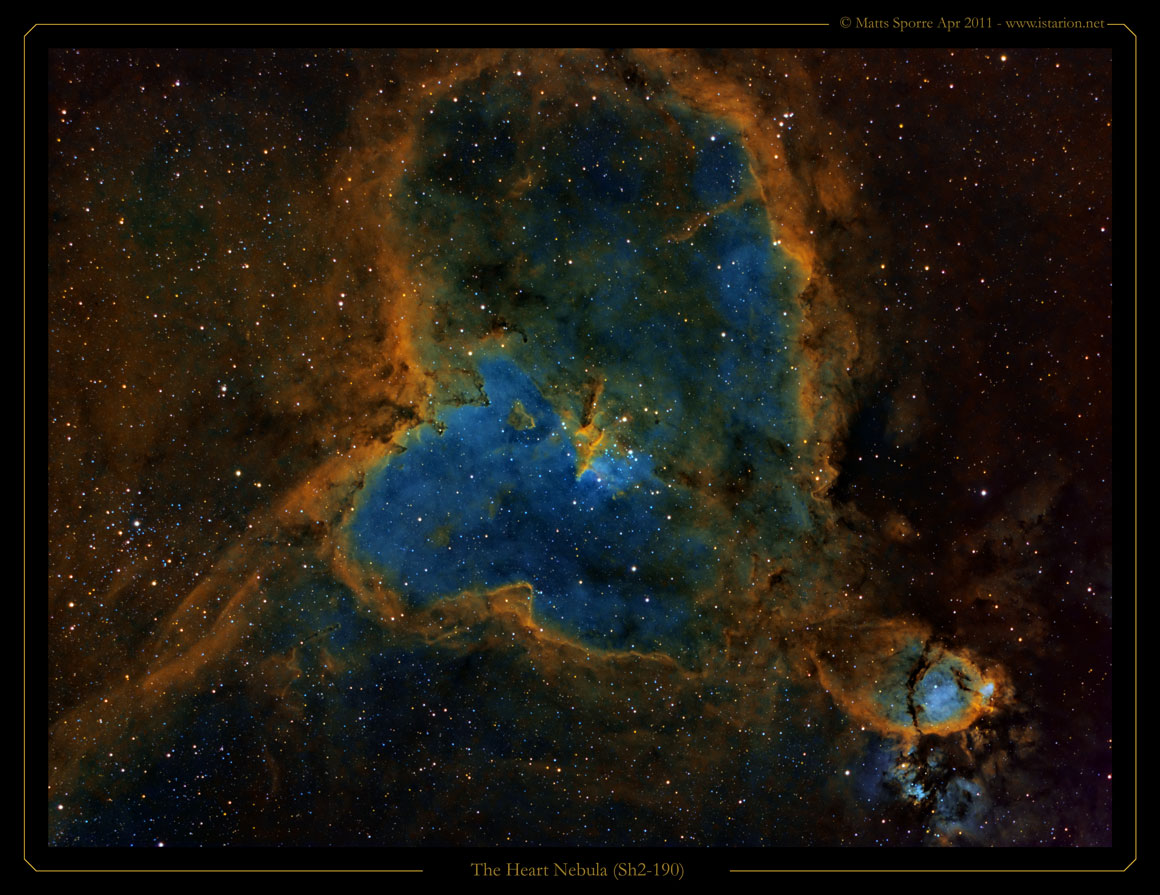The Heart Nebula, IC 1805, Sh2-190, lies some 7500 light years away from Earth and is located in the Perseus arm of the Galaxy in the constellation Cassiopeia. This is an emission nebula showing glowing gas and darker dust lanes. The nebula is formed by plasma of ionized hydrogen and free electrons. The very brightest part of this nebula (the knot at the right) is separately classified as NGC 896, because it was the first part of this nebula to be discovered. The nebula's intense red output and its configuration are driven by the radiation emanating from a small group of stars near the nebula's center. This open cluster of stars known as Melotte 15 contains a few bright stars nearly 50 times the mass of our Sun, and many more dim stars that are only a fraction of our Sun's mass. The cluster used to contain a microquasar that was expelled millions of years ago.
This complex is the western neighbour of the Soul Nebula (Sh2-199) and the two are often mentioned together as the "Heart and Soul".
The above text is taken from Wikipedia.
By "mouse over" on the blue text just below the image you can see:
- Image details: Equipment used, number of subs etc.
- Hubble: Red = SII, Green = Ha, Blue = OIII, Lum = 80%Ha + 10%OIII + 10%SII
- Narrow Band RGB: Red = 80%Ha + 20%SII, Green = OIII, Blue = 85%OIII + 15%Ha, Lum = 80%Ha + 10%OIII + 10%SII
- HaRGB: Red = 20%R(DSLR) + 80%Ha, Green = G(DSLR), Blue = 85%B(DSLR) + 15%Ha, Lum = 80%Ha + 10%G(DSLR) + 10%B(DSLR)
- Ha: just Ha.
Click on the image name in the list to load a 50% image.
The HaRGB version have been obtained by enlargement of the DSLR RGB image and aligning it to the Ha image, which also involves a crop of the RGB as well as a split into R, G and B channels.
For the Hubble and the Narrow Band Colour image I have used JP Metsavainio's Tone Mapping technique - see his blog for details, in order to make maximum use of the weak OIII and SII data.
This was my second real narrow band image (also OIII and SII). From my first (the Soul Nebula) I learned that SII and OIII data is really weak and that it is best to image SII and OIII binned 3x3. For OIII I did bin 3x3 which was a real improvement - but I still need to increase the sub exposure time. I started the SII subs before I processed the Soul Nebula, so by the time I learned that I should bin 3x3 I had already taken SII binned 2x2. Ten or even fifteen min would give more optimal SNR. Just to give an example of how weak the OIII and SII data is (compared to the Ha) I have included below each data set calibrated, integrated and stretched to have the histogram peak at roughly the same value.



Ha OIII SII
The following software has been used. MaximDL (image acquisition and guiding), CCDStack (calibration and RGB scaling, PixInsight (cropping, background correction, colour corrections) and Photoshop CS5 (all the rest, incl Noel Carbonis Astronomy Tools), and finally JP Metsavainio's Tone Mapping technique.
This image was processed in May 2011
Copyright: All images © 2011 Matts Sporre. All Rights Reserved


